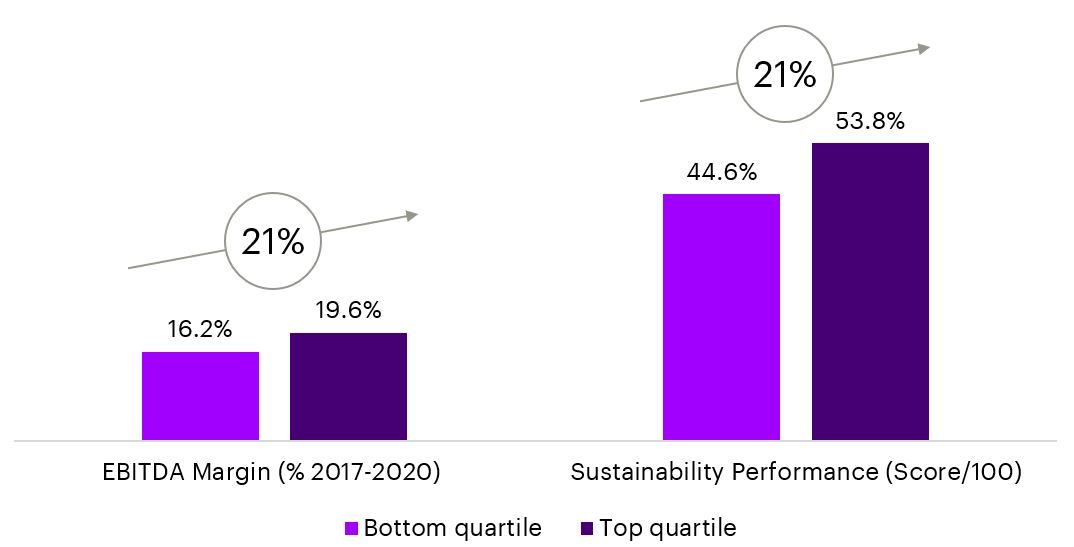Leadership teams across Capital Markets increasingly hold responsible values and good environmental, social and governance (ESG) intentions. This is true not only for many of the new products they develop but also for their own organizations, for very good reasons. However, some may be outrunning the ability of their companies to deliver the necessary behavioral change to bring those values to life. Progress on most of the United Nations’ 17 Sustainable Development Goals has stalled or eroded, according to Accenture research, Delivering on the promise of sustainability.
The recent health, economic and social crises have raised people’s expectations about the role businesses play in solving global problems. While there’s no one-size-fits-all answer, it’s obvious that sustainability needs to be built into the core of all businesses today. This is true from a consumer, employee and investor perspective. We all sink or swim together.
Sustainability in the marrow
I believe that in order to succeed in the future and to build a sustainable organization, all businesses should strengthen their “Sustainability DNA”—a set of management practices, systems and processes that shape new behaviors and decision-making capabilities. These capabilities:
- Foster human connections by sensing and championing the values and needs of diverse (and often unheard) stakeholders across the business ecosystem.
- Boost collective intelligence by developing decision-making processes focused on diverse stakeholders.
- Help to build accountability at all levels, so delivering broad-based stakeholder value becomes the responsibility of all employees.
Interestingly, our research, Shaping the Sustainable Organization, demonstrates that companies with strong Sustainability DNA are more likely to deliver financial value and a lasting positive impact for their people, society and the environment. It shows that companies with the most deeply embedded sustainability management practices outperform their peers by 21% on profitability as well as positive environmental and societal outcomes .
The EBITDA margin of top quartile companies on our Sustainable Organization Index is 21% higher (+3.4 percentage points) compared with the bottom quartile. Their sustainability performance is also 21% higher (+9.2 index points).

Capital Markets’ scorecard on Sustainability DNA
In this latest research, we graded the Sustainability DNA of nearly 4,000 companies globally across various industries. Overall, we found that the average score was 52 out of a possible 100 points. Capital Markets, on average, clocked a score of 48. This result clearly indicates that there is an opportunity for companies to further drive impact and value—across industries as well as in Capital Markets.
Across all industries, we found that organizations tend to be better at building what we called human connections than they are at developing collective intelligence. In other words, they are better at understanding stakeholder perspectives than they are at baking those insights into decision-making. Capital Markets is no exception. For example, in terms of stakeholder inclusion, companies are better at championing human dignity (52/100) than turning that sentiment into tangible empathy (44/100). This points to the fact that there might be a need to further establish practices that enable teams to make more stakeholder-centric decisions.
Interestingly, in one area—Technology & Innovation—Capital Markets bucks the overall trend. It scores higher for progressive technology (47) than for planetary boundaries (42). That speaks to the fact that many companies seem to have appropriate practices in place to monitor the side effects from the use of technology (the topic of responsible AI comes to mind here as an example) but that the links back into what stakeholders want and need could be strengthened.
The time is right, right now
If you want to check your company’s Sustainability DNA, I would encourage you to make use of Accenture’s online diagnostic tool, developed with the World Economic Forum and powered by Arabesque S-Ray—an ESG data provider.
If you want to start working directly to build a more sustainable organization, here are some key thoughts to bear in mind:
- Don’t forget to involve your people. Actively solicit stakeholder feedback on how to meet your sustainability goals. Crowdsourcing that is well incentivized and moves beyond the superficial builds shared ownership.
- It’s always helpful to disaggregate any data that you get (e.g., by department or geography) and triangulate between different data sources and perspectives (e.g., customer, leader, team member) to identify areas of your business where Sustainability DNA is relatively stronger. You can use these to build best-practice case studies, helping to show the rest of the firm how it’s done.
- Finally, the old saying about not being able to manage it if you can’t measure it still holds true. Develop a set of clear KPIs to measure the extent to which Sustainability DNA informs day-to-day decision-making—then build associated incentives into your performance management practices.
There is so much more to this topic, too much to cover in a blog. If you and your team are grappling with sustainability and how to blend it into your business more fully, that’s a conversation I’d be happy to have with you.







